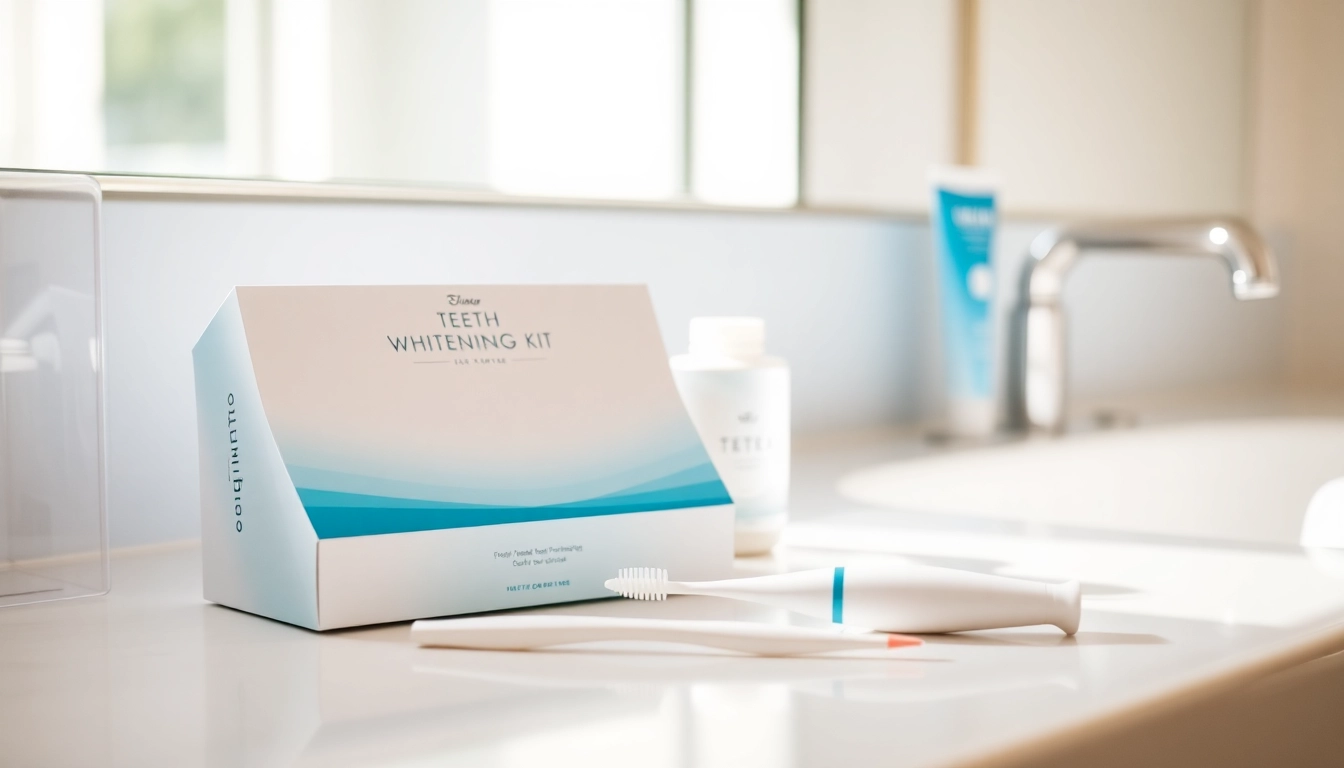Understanding Teeth Whitening Kits
What Are Teeth Whitening Kits?
Teeth whitening kits are specially designed products intended to lighten stained or discolored teeth, providing a brighter smile. They come in various forms, including gels, strips, trays, and pens, which can be used at home or purchased from dental professionals. These kits typically contain bleaching agents such as hydrogen peroxide or carbamide peroxide, known for their effectiveness in breaking down stains and discoloration caused by food, beverages, aging, and other factors. The variety of products available allows consumers to choose based on personal preference, ease of use, and cost.
How Teeth Whitening Kits Work
The primary action of most teeth whitening kits involves oxidation. When applied to the teeth, the active ingredients penetrate the enamel and enter the dentin, where they break apart stains. Hydrogen peroxide is one of the most commonly used bleaching agents because it releases free radicals that react with the colored compounds present on and within the teeth, turning them into colorless compounds, which cannot be seen. This chemical reaction is facilitated by treatments that can vary in strength and duration, thereby impacting the effectiveness and results of the whitening process.
Benefits of Using a Teeth Whitening Kit
Utilizing a teeth whitening kit offers several advantages:
- Convenience: Kits can be used in the comfort of your own home at times that suit your schedule.
- Cost-Effectiveness: Many kits are more affordable than professional treatments and deliver satisfactory results.
- Ease of Use: Most products come with clear instructions, making them accessible even for first-time users.
- Variety of Options: Consumers can choose from different products to find one that meets their preference for formulation, delivery method, and whitening intensity.
Choosing the Right Teeth Whitening Kit
Factors to Consider When Selecting a Kit
When selecting a teeth whitening kit, it’s essential to consider several factors to ensure optimal results:
- Type of Stains: Understand the origin of your stains—surface stains from food or deep stains from aging—as this impacts the type of kit suitable for your needs.
- Sensitivity: If you have sensitive teeth, look for products specifically designed for sensitivity to avoid discomfort during and after treatment.
- Application Method: Choose a method that fits your lifestyle; strips might be easier for some, while others may prefer trays for a more uniform application.
- Duration of Treatment: Some kits offer quick results while others might take longer—consider your time commitment.
Top Ingredients to Look For in Teeth Whitening Kits
The ingredient composition of teeth whitening kits significantly affects their effectiveness and safety. Here are some key components and what to look for:
- Hydrogen Peroxide: A potent bleaching agent that is effective for both at-home and professional whiteners, typically found in concentrations ranging from 3% to 10%.
- Carbamide Peroxide: A derivative of hydrogen peroxide that breaks down into hydrogen peroxide when applied. It’s often considered gentler and more suitable for sensitive teeth.
- Desensitizing Agents: Ingredients like potassium nitrate or fluoride that help reduce sensitivity during and after treatment.
- Whitening Agents: Other components that help enhance whitening effects, such as baking soda or silica, which can assist in stain removal.
Comparing At-Home vs. Professional Kits
Both at-home and professional teeth whitening kits can achieve significant results, but they differ in various aspects:
- Effectiveness: Professional treatments using stronger agents and specialized application techniques usually yield faster and more dramatic changes than at-home products.
- Cost: At-home kits are generally more economical, while professional treatments can be a larger financial investment.
- Convenience: At-home kits can be used whenever you want, whereas professional services often require appointments and can be time-consuming.
- Safety: Professional whitening is done under dental supervision, allowing for monitoring and the minimization of potential side effects.
Using Teeth Whitening Kits Effectively
Step-by-Step Guide to Using Your Teeth Whitening Kit
Follow this step-by-step guide to maximize your teeth whitening results:
- Read Instructions: Always start by reviewing the product instructions to understand how to use it correctly.
- Prepare Your Teeth: Brush and floss your teeth before applying the whitening product to ensure maximum effectiveness by removing plaque and debris.
- Apply the Product: Use the kit as directed. For strips, carefully apply them to your teeth, ensuring they adhere well. For gels or trays, fill them according to the instructions.
- Set a Timer: Adhere to the recommended treatment duration to avoid overuse, which can lead to sensitivity or gum irritation.
- Aftercare: Rinse your mouth thoroughly after use and avoid food or drinks that can stain for at least 30 minutes.
Common Mistakes to Avoid
Learning from common pitfalls can ensure better results with your teeth whitening kit:
- Overusing Products: Using the kit more often than recommended leads to diminishing returns and increases the risk of side effects.
- Not Following Instructions: Skipping steps or ignoring recommended wait times can affect the results negatively.
- Using Expired Products: Always check expiration dates to ensure product efficacy and safety.
- Neglecting Dental Health: Ensure you maintain good oral hygiene practices; whitening works best on healthy teeth.
Maintaining Results After Whitening
To keep your smile bright after whitening, consider these maintenance tips:
- Regular Dental Hygiene: Brush your teeth at least twice a day and floss daily to prevent plaque buildup.
- Avoid Staining Foods: Limit consumption of coffee, tea, red wine, and colorful sauces. If consumed, consider rinsing or brushing afterward.
- Reapply Touch-Ups: Depending on the product, periodic touch-ups may be necessary to maintain your desired brightness.
- Visit Your Dentist: Regular check-ups can help maintain whitening results and dental health overall.
Exploring Natural Alternatives to Teeth Whitening Kits
Natural Remedies for Whiter Teeth
If you prefer a more natural approach to teeth whitening, several remedies can help:
- Baking Soda: Its mild abrasive properties make it an effective tool for removing surface stains.
- Activated Charcoal: Known for its adsorption properties, activated charcoal can attract and remove dental stains.
- Hydrogen Peroxide Paste: A mix of hydrogen peroxide and baking soda can serve as a natural whitening paste when used correctly.
- Fruits and Vegetables: Crunchy fruits and vegetables like strawberries, apples, and carrots can naturally clean teeth due to their texture.
Effectiveness of DIY Teeth Whitening Solutions
While DIY solutions may provide some whitening benefits, their effectiveness can vary greatly. Natural remedies tend to be gentler than commercial kits, but they may not provide the same level of whitening. It’s essential to conduct proper research and possibly consult with a dental professional before starting any DIY whitening regimen to avoid potential damage to the enamel or gum irritation.
When to Consider Professional Treatments
Professional teeth whitening treatments may be necessary in certain situations:
- Deep Stains: If you have intrinsic discoloration, such as that from medication or dental trauma, professional whitening might be a more effective option.
- Severe Sensitivity: If you experience significant discomfort with at-home kits, your dentist can provide tailored treatments with better control over sensitivity.
- Time Constraints: Professional whitening can deliver faster results in one sitting compared to multiple at-home treatments.
Teeth Whitening Kits: Myths and Facts
Addressing Common Myths About Teeth Whitening
Numerous myths surround teeth whitening kits that can misinform consumers:
- Myth 1: All whitening kits work the same. Fact: The effectiveness of a kit can depend on its ingredients, application method, and the user’s individual dental health.
- Myth 2: Whitening damages enamel. Fact: When used correctly, most over-the-counter kits are safe and formulated to minimize damage.
- Myth 3: You only need to whiten once. Fact: Depending on lifestyle factors, periodic touch-ups may be necessary.
Understanding Potential Side Effects
While teeth whitening kits are generally safe, some users may experience side effects:
- Sensitivity: Increased tooth sensitivity can occur during treatment, especially among those with pre-existing sensitivity.
- Gum Irritation: Misapplication or prolonged exposure can lead to gum irritation. Reading instructions can help prevent this.
- Uneven Whitening: Not all teeth may respond to whitening uniformly—especially if the kit is not applied correctly.
Long-Term Care for White Teeth
To keep your teeth bright long-term, focus on holistic dental health:
- Regular Dental Cleanings: Visiting your dentist for routine cleanings can help maintain a bright smile.
- Use Whitening Toothpaste: Incorporating whitening toothpaste into your routine can assist in maintaining brightness.
- Stay Hydrated: Drinking water, especially after meals and beverages that may cause staining, encourages healthier teeth.
- Practice Good Oral Hygiene: A consistent brushing and flossing routine yields remarkable long-term benefits.




